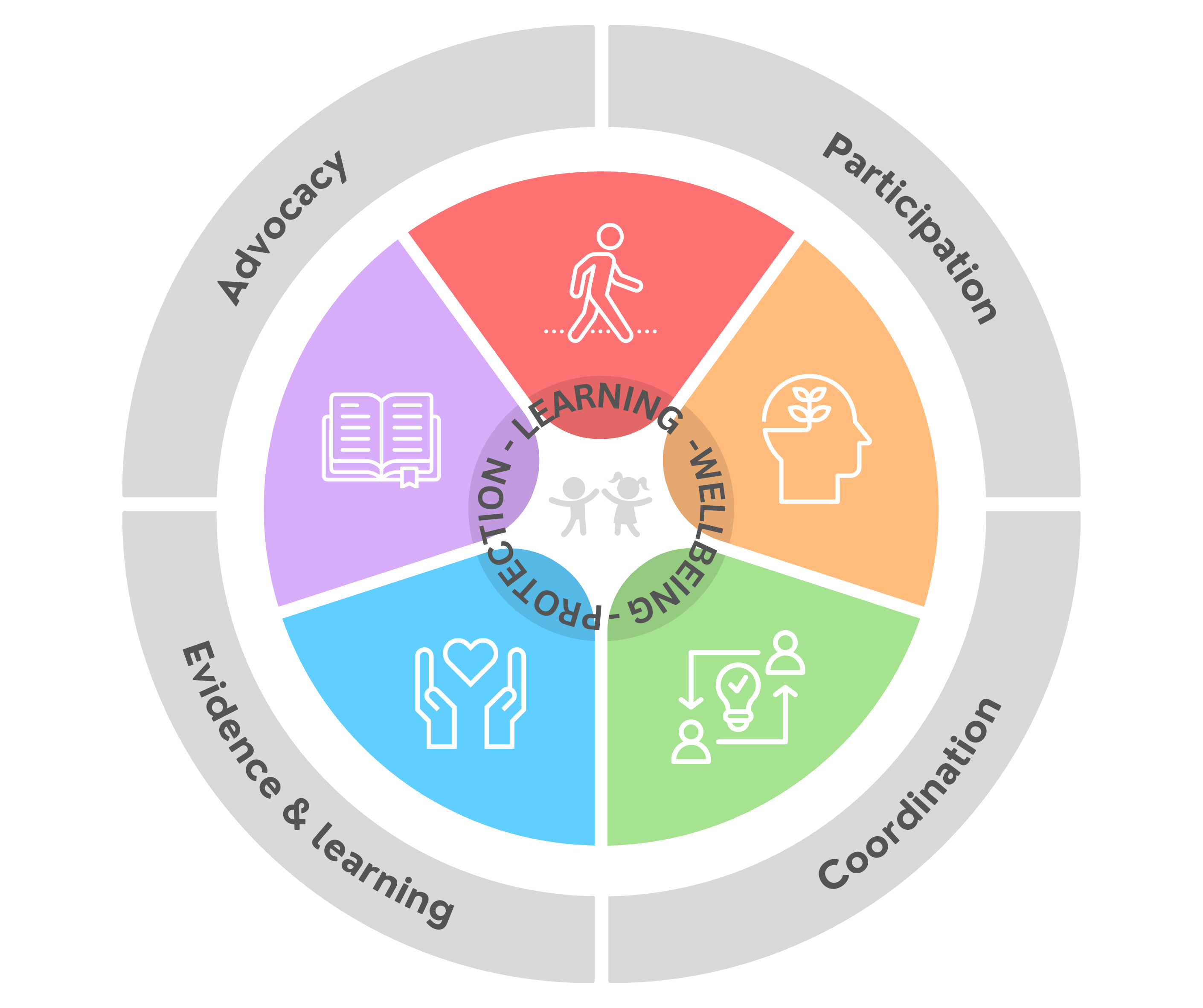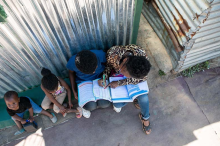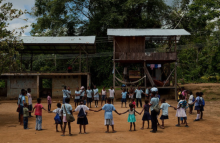
Welcome to the collaborative initiative between the Alliance for Child Protection in Humanitarian Action (CPHA) and the Inter-Agency Network for Education in Emergencies (INEE). This joint effort aims to enhance the wellbeing of children and youth affected by emergencies, crises, and forced displacement through integrated programming. Our work focuses on fostering closer collaboration across all stages of the Humanitarian Programme Cycle. For more information, contact us at: mark.chapple@alliancecpha.org.
Use the buttons below to explore tailored guidance, tools, and resources to help you integrate CPHA and EiE programming in your context.
Cross Sector Collaboration - Overview
CPHA and Education in Emergencies (EiE) are natural partners in humanitarian response. The two sectors have much in common: both are child-focused, are priorities for affected populations, and, through collaboration, they reinforce each other’s sectoral outcomes. Mainstreamed, joint, and integrated programming across CPHA & EiE add value to affected populations, service providers, and donors. Working together can create more efficient, better-targeted, and more effective programs that result in improved outcomes for children and young people (Alliance and INEE, 2021).
The Alliance and INEE are committed to strengthening the intersection between child protection and education during humanitarian crises at all levels of the Humanitarian Programme Cycle and at every stage in a response. The Joint Pledge at the Global Refugee Forum 2023 outlines three areas of shared responsibility and collaboration. They are:
What impact do we want to have with integrated programming:
- Improve child well-being and healthy development
- Improve learning outcomes through holistic support to well-being
- Prevent and mitigate certain protection risks while improving access, retention, and success in learning
- Prevent children “slipping through cracks” between sectors by centering the child in multi-sectoral, integrated programming
- Contribute to efforts to transform humanitarian delivery, and support the localisation agenda for stronger systems and communities in crises
This online resource helps users navigate the key resources that have been developed to support joint and integrated programming, collects tools, good practice examples and case studies, and provides guidance for advocacy and external engagement.
Supporting Change
This page helps users navigate the key resources and tools available to support joint and integrated programming, including good practice examples and case studies, and provides guidance for advocacy and external engagement. Sections are organised around key types of resources and includes an expanded collection of resources aligning with the Supporting Integrated Child Protection and Education in Humanitarian Action Guidance Note programmatic areas of work. The Guidance Note is organised by programmatic areas. Programmatic areas align with the domains and standards from both the Alliance’s Child Protection Minimum Standards (CPMS) and INEE’s Minimum Standards for Education (INEE MS).
Each section of the Guidance Note includes:
- Overview: A shared vision for integrated child protection and education programming in humanitarian responses.
- Guiding Questions: Initial questions to initiate discussions between the two sectors. Questions are organised against the Socio-Ecological Model. Your discussions are guided by the specific circumstances of your context.
- Indicators: Sample list of indicators to determine impact, output, or outcome. MEAL plans must fit the specific objectives and context of each intervention. Many national line ministries and authorities have standard indicators which should be referenced when possible.
- Resources: Key resources that support integrated programs selected through a consultative process with sector practitioners. Adaptation or contextualisation of resources to the realities of communities, systems, and structures impacted by crisis is essential.
- Examples: Spotlight examples of integrated programming in practice.
Looking for something specific? Use the bulleted lists to filter your search. Each area can be filtered for language with the most common languages being Arabic, English, French, Portuguese, and Spanish.

Children Who are at Risk of Their Protection Rights Being Violated (CPMS)
- Adolescents and Youth
- Younger Children (Early Childhood Development and Education)
- Child-Headed Households
- Children with Disabilities
- Gender
- Children on the Move: Refugee/IDP/Stateless/Migrant
- Unaccompanied and Separated Children (UASC)
- Harmful Cultural Practices
- Children in Contact with the Justice System
- Child Labor
- Children Associated with Armed Forces and Groups (CAAFAG)
الموارد الأساسية – السياسات والمناصرة والبحوث
مذكرة توجيهية | دعم البرامج المتكاملة لحماية الطفل والتعليم في العمل الإنساني

تدعم هذه المذكرة التوجيهية مبادرة CPHA-EiE المشتركة للتحالف والشبكة المشتركة لوكالات التعليم في حالات الطوارئ (INEE) من خلال توجيه كلا القطاعين نحو فرص تكامل البرامج. من خلال التعاون، يهدف كلا القطاعين إلى تحقيق الهدف الرابع من أهداف التنمية المستدامة المتمثل في توفير/ضمان "التعليم الجيد المنصف والشامل وتعزيز فرص التعلم مدى الحياة للجميع" بحلول عام 2030. ويعززان أهمية حماية الأطفال ورفاههم في
ورقة أدلة بحثية |لا تعليم، لا حماية: ما يعنيه إغلاق المدارس في ظل تفشي جائحة كوفيد-١٩ بالنسبة للأطفال والشباب في السياقات المتأثرة بالأزمات

أدى تفشي جائحة كوفيد-١٩ إلى مستويات غير مسبوقة من إغلاق المدارس وقد طالت آثار هذا الإغلاق ما يصل إلى 90٪ من طلاب المدارس على مستوى العالم. وفيما كان إغلاق المدارس والمؤسسات التعليمية إجراءً لا بد منه للحد من تفشي الجائحة، توضح هذه الورقة كيف كان لهذا الإغلاق في الوقت ذاته عواقب سلبية أثرت على رفاه الأطفال والشباب، وخاصة أولئك الذين يعيشون في سياق الأزمات الإنسانية.
جاء البحث كمتابعة لورقة السياسة
ورقة موقف | التعاون بين تحالف حماية الطفل في العمل الإنساني و الشبكة المشتركة لوكالات للتعليم في حالات الطوارئ

في هذه الورقة، وضع التحالف و الشبكة المشتركة لوكالات التعليم في حالات الطوارئ الأدلة الداعمة للتعاون والتكامل بين القطاعات، مما يوفر الأساس المنطقي للعمل عبر القطاعات القائمة على رفاهية الطفل والتنمية الشاملة. تتضمن الورقة ملخصًا للتحديات والفرص، وتقدم توصيات واضحة للتعاون المنتظم والمخطط. تستند هذه الورقة إلى أبحاث مستفيضة أجريت طوال عام 2020، مع مدخلات وإشراف من المجموعة الاستشارية لتحالف
التدريب والتطوير
مركز التحالف للتعلم الإلكتروني

يلتزم التحالف بتعزيز قدرات العاملين في مجال حماية الطفل في العمل الإنساني. نعمل معًا على تطوير مواد تعليمية عالية الجودة وتقديمها من خلال فرص التعلم الحضوري، وعبر الإنترنت، والتعلم المدمج.
يضم مركز التعلم الإلكتروني للتحالف جميع موارد التعلم والتطوير الخاصة بالتحالف. تضم منطقة المتعلمين محتوى التعلم الذاتي، بما في ذلك دورة CPMS الإلكترونية، باللغات العربية والإنجليزية والفرنسية والإسبانية. كما
التعلم والتطوير مع INEE

مع تزايد تعقيد الأزمات التي يواجهها العالم وطول أمدها، يتزايد باستمرار عدد الأطفال والشباب المعرضين للخطر في حقهم في التعليم. ولتلبية هذه الاحتياجات المعقدة، يجب على جميع الممارسين والجهات المعنية مواصلة تطوير معارفهم ومهاراتهم في مجال التعليم في حالات الطوارئ، ليتمكنوا من "ضمان الحق في تعليم جيد وآمن ومناسب لجميع من يعيشون في سياقات الطوارئ والأزمات، من خلال الوقاية والتأهب والاستجابة والتعافي".

